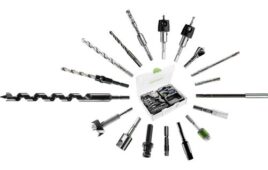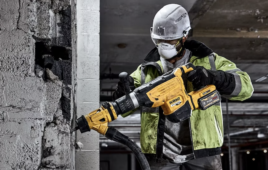Stanley Black & Decker has released the results of its inaugural Makers Index, an in-depth research study examining sentiment about skilled trade careers in the U.S., with the goal of better understanding some of the underlying causes of the skilled trade labor shortage.

Only 49% of females are likely to consider a skilled trades career. The full Makers Index findings can be found here.
The study surveyed three core audiences: high schoolers aged 14-19, parents of high schoolers, and skilled trade workers.
The findings revealed a paradox that underscores the challenges associated with the skilled trade shortage: young people are not seriously considering it. While 85% of young people and 94% of parents think that skilled trade work is a good quality career option in general, less than half (49%) of youth have ever considered a skilled trade career, and far fewer (16%) are very likely to consider a skilled trade career.
“The skilled labor shortage is one of the biggest challenges facing the U.S. economy, with 650,000 open jobs in the construction industry alone,” said Stanley Black & Decker CEO Jim Loree. “This problem existed long before the pandemic but has certainly been exacerbated by it. We must address this issue, or we risk even greater labor shortages in the future.”
The Makers Index study reveals a pathway to solve this challenge: collectively, there is more we can do to make trade careers resonate with young people.
“We can increase career and technical education programs at schools and ensure students appreciate the income potential and lifestyle advantages of skilled trade careers,” added Loree. ‘Businesses, government, civic leaders, educators, school administers, teachers, and parents play a critical role in helping to develop and nurture the next generation of skilled trade workers. Working together, we can make progress toward solving the skilled trades shortage.”
A closer look at the data reveals four key drivers of the skilled trades gap:
1. Misunderstanding of long-term financial security
Not surprisingly, 81% of young people and 78% of parents are concerned about the potential cost of education after high school. Perhaps as a result, 87% of young people and 93% of parents say starting a career sooner than it takes to finish a four-year degree is appealing.
The skilled trades could offer young people a way forward, but young people are underestimating the starting earning potential for skilled trades. Only 42% expect skilled trade workers to earn at least $50,000, and 19% of young people think the starting pay for a skilled trade worker is less than $20,000. In fact, half of current skilled trade workers with less than 10 years’ experience earned at least $50,000 to start.
Of the younger people surveyed, 43% were much more positive about a skilled trade career when presented with the fact that after five years, a person who attends trade school and then starts working will be $140,000 ahead, on average, compared to a student who enrolls in a four-year college before working.
2. Incorrect knowledge of required skills
There has long been a narrative that young people don’t want to enter the skilled trades because they dislike the idea of working in manual labor, but of the 40% of young people who don’t believe a skilled trade career is a good option, only 12% cited a dislike of manual labor as their primary reason.
The main reason cited by those 40% of young people — by a long margin — was poor fit or lack of skills. Broadening an understanding of the skills needed for a skilled trade career can help address this sentiment.
At the same time, most young people have outdated perceptions of the trades, with 23% disagreeing that skilled tradespeople work with cutting edge technology and 18% disagreeing about the work being high in demand. Those beliefs are in contrast with reality: 89% of workers said they work with cutting-edge technology and 94% say that their jobs are high in demand.
3. Lack of exposure to individuals currently in trade profession
Young people lean heavily on people they know — including parents (48%), friends and classmates (44%) as well as teachers (43%) — for help and information related to post-high school planning. But only 42% have had a conversation about skilled trade careers with someone in those fields, while 37% have never had a conversation with anyone about skilled trade careers. It’s no wonder that only 29% feel very well informed about how to start down the path of these careers.
Media and entertainment still play an important role in shaping career choices. More than six in 10 skilled workers with less than 10 years of experience said that media (print, online, social, ads, etc.) was influential and helpful in thinking about career plans, with the internet (32%) and social media (21%) being primary drivers.
4. Continued male-dominated industry
When it comes to skilled trades, there are discrepancies in knowledge, consideration and appeal between genders. When asked about their familiarity with skilled trades, teen boys are more familiar than teen girls (53% vs. 36%), and in thinking about the future, boys are more likely to consider a career in a skilled trade (64% vs. 49%).
When asked if a skilled trade career seems like a good option for them, 69% of boys agree, but only 52% of girls agree. This same dynamic exists among parents. While men and women have the same opinions about whether skilled trades careers are good-quality options, men are more than twice as likely as women to say a skilled trade career is a very appealing option for their child (47% to 22%).
To help solve the skilled talent shortage, there needs to be a focus on driving more engagement with women to help them become more aware of these careers and their benefits.
In 2021, Stanley Black & Decker launched the Empower Makers Global Impact Challenge, a five-year, up to $25 million commitment to fund vocational skills training and reskilling programs in the construction and manufacturing sectors. The Impact Challenge is expected to skill and reskill up to three million makers over the next five years.
The company recently announced the first Makers Grants to 86 nonprofits including high schools, community colleges, construction-focused programs, makerspaces, and vocational and trade schools. These recipients will create vital trade programs and help new generations learn how they can help build what matters.
The full list of recipients can be found here.





Tell Us What You Think!